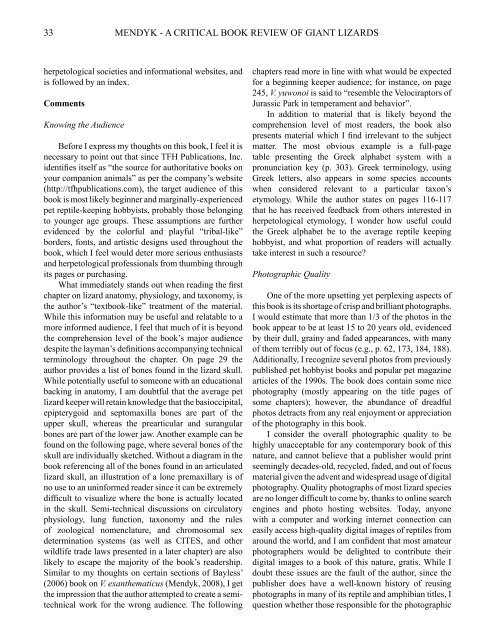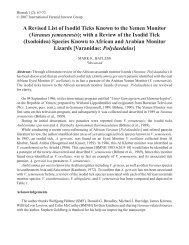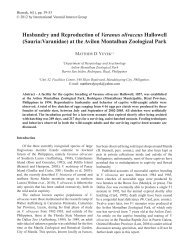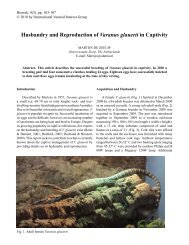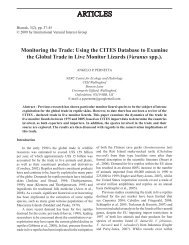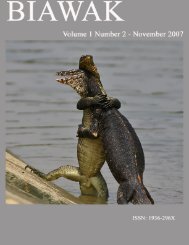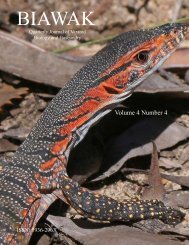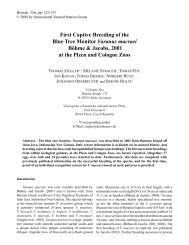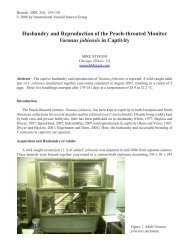Vol. 4 No. 1 - International Varanid Interest Group
Vol. 4 No. 1 - International Varanid Interest Group
Vol. 4 No. 1 - International Varanid Interest Group
You also want an ePaper? Increase the reach of your titles
YUMPU automatically turns print PDFs into web optimized ePapers that Google loves.
33<br />
herpetological societies and informational websites, and<br />
is followed by an index.<br />
Comments<br />
Knowing the Audience<br />
MENDYK - A cRITIcAL BOOK REVIEW OF gIANT LIZARDS<br />
Before I express my thoughts on this book, I feel it is<br />
necessary to point out that since TFH publications, Inc.<br />
identifies itself as “the source for authoritative books on<br />
your companion animals” as per the company’s website<br />
(http://tfhpublications.com), the target audience of this<br />
book is most likely beginner and marginally-experienced<br />
pet reptile-keeping hobbyists, probably those belonging<br />
to younger age groups. These assumptions are further<br />
evidenced by the colorful and playful “tribal-like”<br />
borders, fonts, and artistic designs used throughout the<br />
book, which I feel would deter more serious enthusiasts<br />
and herpetological professionals from thumbing through<br />
its pages or purchasing.<br />
What immediately stands out when reading the first<br />
chapter on lizard anatomy, physiology, and taxonomy, is<br />
the author’s “textbook-like” treatment of the material.<br />
While this information may be useful and relatable to a<br />
more informed audience, I feel that much of it is beyond<br />
the comprehension level of the book’s major audience<br />
despite the layman’s definitions accompanying technical<br />
terminology throughout the chapter. On page 29 the<br />
author provides a list of bones found in the lizard skull.<br />
While potentially useful to someone with an educational<br />
backing in anatomy, I am doubtful that the average pet<br />
lizard keeper will retain knowledge that the basioccipital,<br />
epipterygoid and septomaxilla bones are part of the<br />
upper skull, whereas the prearticular and surangular<br />
bones are part of the lower jaw. Another example can be<br />
found on the following page, where several bones of the<br />
skull are individually sketched. Without a diagram in the<br />
book referencing all of the bones found in an articulated<br />
lizard skull, an illustration of a lone premaxillary is of<br />
no use to an uninformed reader since it can be extremely<br />
difficult to visualize where the bone is actually located<br />
in the skull. Semi-technical discussions on circulatory<br />
physiology, lung function, taxonomy and the rules<br />
of zoological nomenclature, and chromosomal sex<br />
determination systems (as well as cITES, and other<br />
wildlife trade laws presented in a later chapter) are also<br />
likely to escape the majority of the book’s readership.<br />
Similar to my thoughts on certain sections of Bayless’<br />
(2006) book on V. exanthematicus (Mendyk, 2008), I get<br />
the impression that the author attempted to create a semitechnical<br />
work for the wrong audience. The following<br />
chapters read more in line with what would be expected<br />
for a beginning keeper audience; for instance, on page<br />
245, V. yuwonoi is said to “resemble the Velociraptors of<br />
Jurassic park in temperament and behavior”.<br />
In addition to material that is likely beyond the<br />
comprehension level of most readers, the book also<br />
presents material which I find irrelevant to the subject<br />
matter. The most obvious example is a full-page<br />
table presenting the greek alphabet system with a<br />
pronunciation key (p. 303). greek terminology, using<br />
greek letters, also appears in some species accounts<br />
when considered relevant to a particular taxon’s<br />
etymology. While the author states on pages 116-117<br />
that he has received feedback from others interested in<br />
herpetological etymology, I wonder how useful could<br />
the greek alphabet be to the average reptile keeping<br />
hobbyist, and what proportion of readers will actually<br />
take interest in such a resource?<br />
Photographic Quality<br />
One of the more upsetting yet perplexing aspects of<br />
this book is its shortage of crisp and brilliant photographs.<br />
I would estimate that more than 1/3 of the photos in the<br />
book appear to be at least 15 to 20 years old, evidenced<br />
by their dull, grainy and faded appearances, with many<br />
of them terribly out of focus (e.g., p. 62, 173, 184, 188).<br />
Additionally, I recognize several photos from previously<br />
published pet hobbyist books and popular pet magazine<br />
articles of the 1990s. The book does contain some nice<br />
photography (mostly appearing on the title pages of<br />
some chapters); however, the abundance of dreadful<br />
photos detracts from any real enjoyment or appreciation<br />
of the photography in this book.<br />
I consider the overall photographic quality to be<br />
highly unacceptable for any contemporary book of this<br />
nature, and cannot believe that a publisher would print<br />
seemingly decades-old, recycled, faded, and out of focus<br />
material given the advent and widespread usage of digital<br />
photography. Quality photographs of most lizard species<br />
are no longer difficult to come by, thanks to online search<br />
engines and photo hosting websites. Today, anyone<br />
with a computer and working internet connection can<br />
easily access high-quality digital images of reptiles from<br />
around the world, and I am confident that most amateur<br />
photographers would be delighted to contribute their<br />
digital images to a book of this nature, gratis. While I<br />
doubt these issues are the fault of the author, since the<br />
publisher does have a well-known history of reusing<br />
photographs in many of its reptile and amphibian titles, I<br />
question whether those responsible for the photographic


